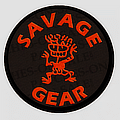Using Abalakovs:
Back the thread up with a good screw placement, test it with a bounce or two,
and leave the backup in until the first person who raps has had a chance to clip
a new anchor below. On the popular lines at Lake Willoughby at the end of most
seasons, you can look 80 feet in just about any direction and find a resident
v-thread. It looks like the place has been grid-bolted! Resident v-threads are likely
to be safe to use if they look as good as a freshly placed one. Use your own judgement
and if in doubt place a new one. Remember that v-threads are cheap, your life
isn't!
Beware: there has been at least one fatal accident involving reuse of an existing
thread. Several years ago in the Canadian Rockies a climber died when he mistakenly clipped
a long tail of a v-thread runner that had frozen into the ice, instead of clipping
the main loop. He would likely have survived if he had backed up with a screw.
There is one potential environmental drawback to the V-Thread's popularity - they
end up on the ground in the spring. So if you place them, think about touring
your local ice crag in the late spring and doing a cleanup.
Can I belay off them?
Well, the jury is still out. They have been extensively and successfully field
tested as rappel anchors. A few years ago Mark Twight cited a University of Calgary strength test
where V-Threads supported loads between 15 and 20 KN in good dry ice. This is
certainly as good as most other points in a belay chain (small wired nuts can
be rated as low as 4 KN!). I have not been able to review this test report though,
and I have not found any other research or qualified opinion that questions or
supports belaying off a thread.
Intuitively, I think I would trust a tread because studies of ice screw failure
often show that the metal tubes of the screw fail before the ice into which they
are placed fails. Many guides and ice climbing instructors like Jeff Lowe and
Will Gadd suggest slinging icicles as pro. But until some more serious and scientific
tests are conducted, I can not recommend them as points of protection. Whatever
you do on lead must be a personal decision.
The Gear:
Several companies sell hooking tools for making v-threads. It is pretty darn easy
to make a good one yourself, and in the next section I will describe how to do
just that. But here are my reviews of the ready-mades. They all cost about $10.
Besides a tool, hang a couple two foot to three foot lengths of you favorite color
9/16 supertape on a 'biner, and you are all set.
The Simond (or Braun) Abalahook is a steel cable with a swadged loop on one end
(like a wire nut) and a hook on the other. It is flexible, which can be a pain
to use in a deep hole. Its rubber protective cap (for the hook) can easily ride
up the cable, exposing the hook to your new Gore-tex.
The Charlet Moser MultiHook is a swank solid metal job, so you can also use it
to clean out ice-packed screws. It does include a useless hex nut wrench (that's
the Multi in MultiHook).
Grivel's V-anchor Hook is a cheap scrap of wire without a protective cap. Not
even funny! Send me $10 and I will give you my cheap scraps of old wire!
References:
"Mechanical Advantage" by John
Middendorf. A fascinating history of climbing gear development, including
Vitaly Abalakov's accomplishments.
"Ice Climbing Anchor Strength" by George McEwan of UKClimbing.com. George takes a look at a study of ice anchors
and explores the findings. Just how strong are abolokov threads and re-bored ice screws?
Here's the article.
"Myths, Cautions, and Techniques of Ice Screw Placement" by Chris Harmston
of Black Diamond Equipment. This is the research that taught us to place ice screws
pointing down rather than up. Chris is always a great read, and this is the
crucial article.
"Accidents in North American Mountaineering" from the American Alpine
Club. Learn from those who blow it.
Fish Products - Interesting articles on strength tests of gear, including more Chris Harmston
posts on rec.climbing
"Ice Anchor Review", Joe Josephson, The Canadian Alpine Journal, 76,
1993, pp66-67
"Getting Down on a Shoestring", Murray Toft and Joe Josephson, Climbing
Magazine, 124, Feb/March 1991, pp100-103
"Extreme Alpinism" Mark Twight and James Martin. Must read!
Ice links from Will Gadd
|






















